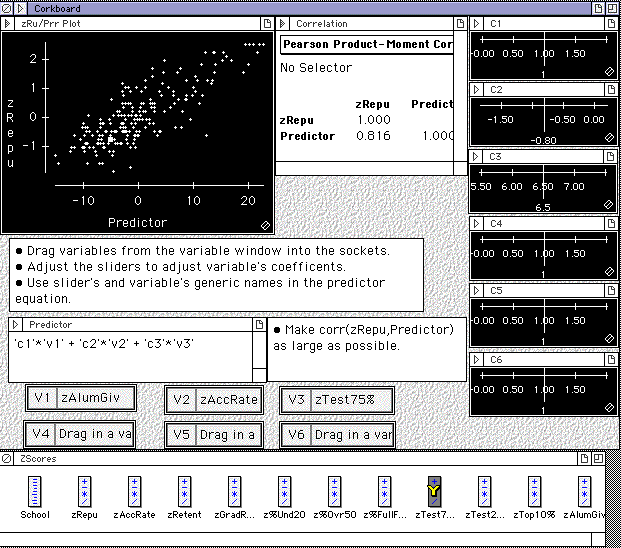BH Statistics
November 10, 1999
Predicting Reputation
Ratings
The data in Colleges
1-230 are from the US News &World Report.
It is data on what they considered to be the top 230 colleges and universities
in the United States. All the variables in this data set are defined in the
Appendix.
One of the variables in this data set is called
Reputation. It is the mean rating (1 lowest to 5 highest) given to a
college by faculty and administrators at other institutions. We do
not know the thought processes of these people; all we know is the
mean of the ratings they gave to each college.
We also have data in the file named CollegesAll.
This data is on 1303 colleges and universities in the United States. It is not
quite the same as Colleges 1-230. Not only does it contain data on colleges
that are not in the top 230. Each data set has information that is not contained
in the other. One item of information that we have on the Colleges 1-230
that we don't have in CollegesAll is each college's reputation rating.
Your task is to come up with a way to calculate
a reputation rating for schools that don't have one from information
that you have on the schools, and to do so in a way that the ratings
are consistent with those that were given to schools having one. Put
another way, if you use your method to assign reputation ratings to
schools that already have one, then the ones you assign by using your
method should be consistent with the ratings they actually
have.

Appendices
Appendix
I: Variables in Colleges 1-230
College
College name. The college's name
(and state, if ambiguous).
Reputation
Academic reputation. The average
rating of the quality of a school’s academic programs as
evaluated by officials at similar institutions. The survey was
conducted in the spring of 1998.
AcceptRate
Acceptance rate. The ratio of the
number of students admitted to the number of applicants for the
fall 1997 admission.
GradRate
Graduation rate. Percent of freshman
who graduated within a six-year period, averaged over the classes
entering between 1988 and 1991.
%ClassesUnder20
Class size, 1-19 students. The
percentage of undergraduate classes, excluding class sections,
with fewer than 20 students enrolled during the fall of
1997.
%ClassesOver50
Class size, 50+ students. The
percentage of undergraduate classes, excluding class sections,
with 50 students or more enrolled during the fall of
1997.
%FullTimeFac
Full-time faculty. The proportion of
total faculty employed on a full-time basis during the 1997
academic year.
%TopTen%
High school class standing. The
proportion of students enrolled for the fall 1997 academic year
who graduated in the top 10 percent (for national universities and
liberal arts colleges) or 25 percent (for regional universities
and liberal arts colleges) of their high school class.
SAT.ACT75%
Highest Quartile Test Scores. The
lowest SAT or ACT score in the top quartile of entering freshmen.
That is, the score that is the lowest score made by a student in
the highest 25% of SAT or ACT scores among freshman at that
school. Scores less than or equal to 36 are combined ACT scores.
Scores above 100 are combined SAT scores.
SAT.ACT25%
Lowest Quartile Test Scores. The
highest SAT or ACT score in the bottom quartile of entering
freshmen. That is, the score that is the highest score made by a
student in the lowest 25% of SAT or ACT scores among freshman at
that school. Scores less than or equal to 36 are combined ACT
scores. Scores above 100 are combined SAT scores.
AlumGiv
Alumni giving. Percent of
undergraduate alumni who donated money to the college or
university, averaged over the 1996 and 1997 rates.
Appendix
II: Variables in Colleges All
College
College name. The college's name
(and state, if ambiguous).
State
State of college. The state in which
the college is located.
Pub/Priv
Public or Private. Whether the
college is a publicly or privately funded.
AcceptRate
Acceptance rate. The ratio of the
number of students admitted to the number of applicants for the
fall 1997 admission.
GradRate
Graduation rate. Percent of freshman
who graduated within a six-year period, averaged over the classes
entering between 1988 and 1991.
%FullTimeStu
Percent of full time students. The
percent of the undergraduate students who are attending school
full time (at least 12 term hours per term).
%TopTen%
High school class standing. The
proportion of students enrolled for the fall 1997 academic year
who graduated in the top 10 percent (for national universities and
liberal arts colleges) or 25 percent (for regional universities
and liberal arts colleges) of their high school class.
%FacPhD
Percent of Faculty with Ph.D. The
percent of the institution's faculty who have the highest
available degree in their field of expertise.
SAT.ACT75%
Highest Quartile Test Scores. The
lowest SAT or ACT score in the top quartile of entering freshmen.
That is, the score that is the lowest score made by a student in
the highest 25% of SAT or ACT scores among freshman at that
school. Scores less than or equal to 36 are combined ACT scores.
Scores above 100 are combined SAT scores.
SAT.ACT25%
Lowest Quartile Test Scores. The
highest SAT or ACT score in the bottom quartile of entering
freshmen. That is, the score that is the highest score made by a
student in the lowest 25% of SAT or ACT scores among freshman at
that school. Scores less than or equal to 36 are combined ACT
scores. Scores above 100 are combined SAT scores.
AlumGiv
Alumni giving. Percent of
undergraduate alumni who donated money to the college or
university, averaged over the 1996 and 1997 rates.

